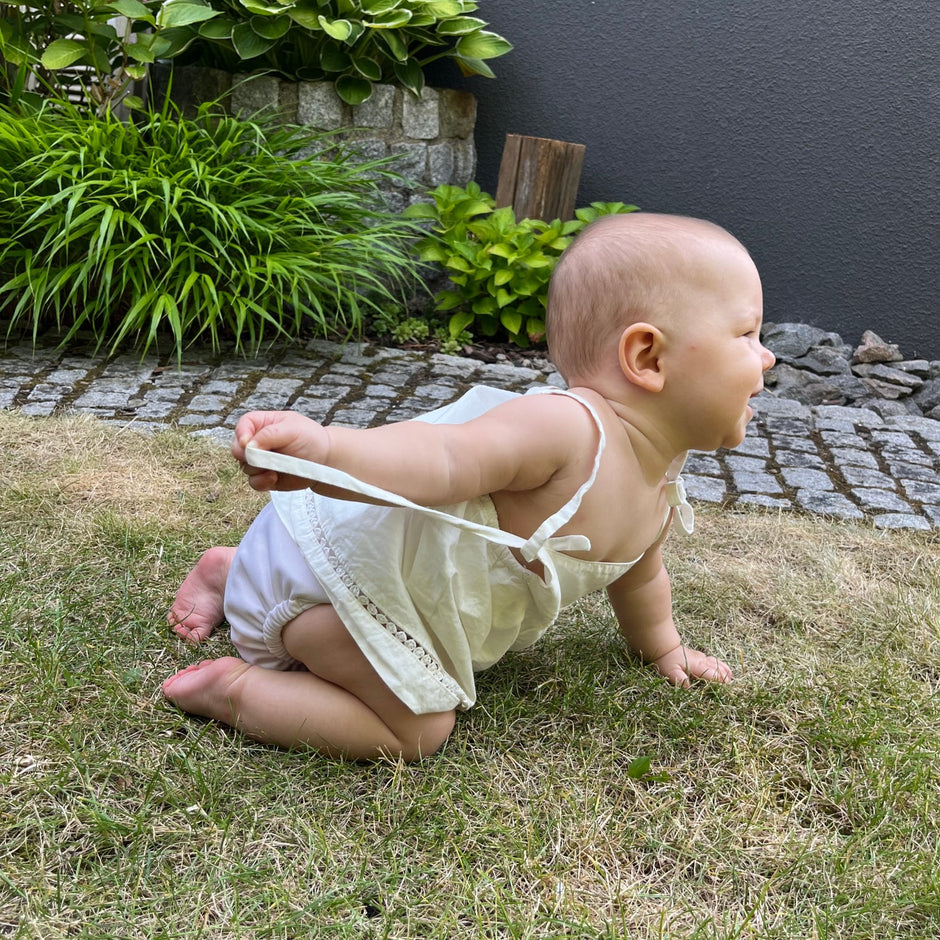Starting Right: How to Diaper Your Baby with Cloth Diapers
Updated on:
Photo by @madame.vio
Cloth diapers wonderfully combine sustainability, skin-friendliness, and cost-effectiveness. The decision to use cloth diapers is a significant step for environmentally conscious parents who want the best for their baby and our planet. In this guide, we will delve into the topic of cloth diapers and show you how to properly diaper your baby from the start.
How do I properly put on cloth diapers? To properly put on cloth diapers, first position your baby on a clean surface and place the absorbent inner diaper under your baby's bottom. Ensure that the diaper is centered and sits high enough at the front and back before fastening it loosely but securely around your baby's waist. Then, pull a waterproof cover over it to ensure that the diaper fits well and does not leak. Make sure it has a comfortable fit, tight enough to prevent leaks but not so tight as to restrict your baby.
Cloth diapers have evolved tremendously since their inception and today offer a practical, comfortable, and stylish alternative to conventional disposable diapers. With a variety of designs and materials available on the market, the switch to cloth diapers may initially seem overwhelming. But don't worry, we make it as easy and comfortable as possible for you.
Why Cloth Diapers? A Brief Overview
Choosing cloth diapers offers a multitude of benefits that affect both your baby and the environment. Compared to conventional disposable diapers, cloth diapers score points in many areas.
Benefits of Cloth Diapers
- Eco-friendliness: Cloth diapers are reusable and therefore reduce the waste that is produced by the use of disposable diapers. They significantly help decrease the amount of diaper waste that ends up in landfills. Additionally, they are more resource-efficient because they require less energy and raw materials for production.
- Cost-effectiveness: Although the initial investment in cloth diapers may be higher, you save money in the long run. Cloth diapers can be used for years and for multiple children, while disposable diapers mean continuous expenses.
- Skin-friendliness: Cloth diapers are made from natural materials that are gentler on your baby's sensitive skin. They contain no chemical additives, like those found in disposable diapers, which can cause diaper rash or allergic reactions.
- Earlier Potty Training: Cloth diapers provide the child with immediate wetness feedback once they wet themselves. Unlike the constant dryness of disposable diapers, children can feel when they go in the diaper. This accelerates physical development and understanding of bodily functions. According to a survey of 5,000 parents, children who were diapered with Judes became potty trained nearly a year earlier on average.
Did you know you can also easily perform wide wrapping with cloth diapers? Learn more about this on our blog.
Different Types of Cloth Diapers
- Prefold and Flat: Flat fabrics that are folded and used with a cover. They are cost-effective and versatile but require some practice in handling and are more labor-intensive to prepare.
- Fitted: These diapers have a pre-shaped fit and offer high leak protection. They also require a cover and offer less flexibility.
- All-in-One (AIO): AIOs combine the absorbent layer and the cover in one product, making them a pragmatic solution. However, as all parts of the diaper are sewn together, a larger number of diapers is needed. Additionally, AIOs are difficult to adjust to the child's needs and therefore tend to leak.
- Pocket Diapers: They consist of a waterproof outer layer with an inner pocket where absorbent inserts can be placed. They are somewhat more complicated to use and less cost-efficient, as larger quantities of covers are needed.
- Judes: Judes combine the advantages of various different diapers. The inner diaper is extremely absorbent and the cover provides moisture protection. Additionally, Judes are particularly easy to use and offer high comfort and leak protection with flexible bands.
Choosing the right cloth diaper and its correct application are crucial for your baby's comfort and satisfaction. A well-fitting cloth diaper prevents leaks, promotes good airflow, and keeps your baby's skin dry. Proper care and maintenance of the cloth diapers, such as regular washing and proper drying, ensure their longevity and effectiveness.
Cloth diapers therefore offer a practical, eco-friendly and cost-effective alternative to disposable diapers. With Judes, which are specifically tailored to the diverse needs of babies and parents, it is easier than ever to transition to a more sustainable and skin-friendly diapering solution.

Photo by @isabelplett
Choosing the Right Cloth Diapers
Choosing the right cloth diapers for your baby is an important step to ensure comfort, effectiveness, and satisfaction. The type of cloth diaper plays a critical role in this. Judes offers a simple yet ideal solution for families who value quality, sustainability, and user-friendliness.
Size Selection and Fit
Choosing the right size and fit is crucial to prevent leaks and ensure that your baby stays dry always. At Judes, you will find two sizes to guide you through the entire diapering period. With infinitely adjustable Velcro fasteners and flexible bands at the back and legs, they adjust to any body shape and provide optimal protection for both newborns and active toddlers.
Different Levels of Activity and Ages
Your baby's needs change with increasing age and activity level. Cloth diapers from Judes offer the flexibility you need to keep up with these changes:
- For Newborns, particularly soft and absorbent materials are important, which protect sensitive skin and support its natural regenerative ability. Judes inner diapers are made of 100% organic cotton, which is both absorbent and soft as well as breathable.
- Active Babies benefit from a secure fit and diapers that provide freedom of movement without slipping. Judes are designed to perfectly adapt to every age and activity level.
- For older babies and toddlers, especially during the transition to potty training, the simple and quick-change systems promote independence and ease the transition. Judes are designed to be as easy to use as disposable diapers. Parents even report that changing Judes diapers is even easier.
By choosing the right type, size, and fit of cloth diaper for your baby's needs, you can effectively prevent leaks while ensuring your baby's comfort. Judes are the ideal option if you are looking for a sustainable, simple, and stylish diapering solution for your baby.
Preparing Cloth Diapers Before First Use
Before using cloth diapers for the first time, careful preparation is crucial to ensure their performance and longevity. Here are some steps you should follow to maximize absorbency and ensure efficient use.
Judes' cloth diapers make it particularly easy for you, as they are ready to use immediately after the first wash. They reach their full absorbency around the eighth wash.
Here are some tips for the first washes:
- First Wash: Wash the diapers once before the first use to remove any production residues and to loosen the fibers.
- Increasing Absorbency: Wash the diapers regularly during the first few weeks to gradually reach maximum absorbency. You do not have to wait until you have done eight washes before using Judes; the absorbency improves with each wash.
- Detergent: Use a mild, eco-friendly detergent that is free from fragrances, bleaches, and fabric softeners to preserve the materials of the cloth diapers. Our Judes Family Care Detergent is perfectly coordinated with the needs of our cloth diapers.
Tips for Storage and Organization
Good organization is key to making the diapering process with cloth diapers smooth and efficient.
- Storage: Store clean cloth diapers in an easily accessible place near the changing area. Open shelves or drawers allow for quick access.
- Pre-sorting: Sort the diapers into the categories day and night, so you can quickly have the right diaper on hand as needed. Also, keep additional inserts, like boosters or poo paper, and covers within reach.
Selection and Preparation of Additional Inserts
Additional inserts can increase the absorbency of cloth diapers, which is especially useful at night or during longer trips.
- Newborns and Overnight: For newborns or nighttime use, additional inserts made from absorbent materials, known as boosters, are recommended. They increase the capacity without unnecessary bulk. You can find more tips for nightly cloth diapering on our blog.
- Preparation: Wash the additional inserts before first use as well. Note that, like the diapers themselves, they become more absorbent with each wash.
By following these preparation and organization steps, you ensure that the cloth diapers can be optimally used from the start. Good preparation significantly eases everyday life with cloth diapers and ensures a positive experience for you and your baby.

Photo by @ammenmaerchen
Step-by-Step Guide to Diapering with Cloth Diapers
Diapering with cloth diapers might seem complicated at first, but with a little practice, it quickly becomes routine. When you use Judes, you'll need no adjustment period because we make it particularly easy for parents. Our cloth diapers are just as easy to put on as disposable diapers. Here is a detailed guide on how to diaper your baby with Judes cloth diapers:
Positioning the Baby
- Preparation: Have everything you need for diapering within reach. This includes the absorbent inner diaper, the PUL cover, any additional inserts, and washcloths for cleaning.
- Position your baby: Lay your baby on their back on a clean, soft surface. Gently lift the legs to slide the inner diaper under your baby's bottom.
Tip: Judes are so easy to use that older children can also be diapered while standing.
Putting on the Inner Diaper
- Alignment: Ensure that the inner diaper is centered under your baby. The front edge should be approximately at the level of the navel.
- Attachment: Fasten the diaper loosely with the Velcro closures. It should be positioned so that you can fit about two fingers between the diaper and your baby's belly.
Putting on the PUL Cover
- Placement: Gently lift your baby's legs and slide the PUL cover under the bottom. The cover should fully cover the inner diaper.
- Adjust for Comfort and Leak Protection: Ensure that the cover fits well at the leg openings and around the waist but is not too tight. The elastic bands should be snug enough to prevent leaks, yet comfortable to allow freedom of movement and avoid pressure marks.
- Check: Make sure the inner diaper is completely covered by the cover and no parts are peeking out to effectively keep moisture out.
But don't worry: You'll intuitively get it right. Judes are designed so that you actually don't need any instructions.
Further Tips for Using Covers
- Reuse: The PUL cover from Judes can be used multiple times before it needs to be washed, as long as it hasn't come into contact with stool or large amounts of urine. This simplifies the diapering process and saves time. Additionally, this benefit means you need fewer covers compared to other diapers.
- Care: If the cover needs cleaning, follow Judes' care instructions to maximize its lifespan. Until then, simply air out the cover between diaper changes.
With this step-by-step guide, you can diaper your baby easily and safely with Judes. With Judes, diapering with cloth diapers quickly becomes an easy and satisfying part of your daily routine.
Tip: On our blog, you will find helpful tips for diapering with meconium and breast milk stool.
Care of Cloth Diapers
Proper care of your cloth diapers preserves their absorbency and longevity. With the right care practices, you can avoid common problems such as odors, stains, or decreasing absorbency and ensure that the diapers are always comfortable and effective for your baby.
Washing and Drying Cloth Diapers
- Main wash: Wash the diapers in the machine at 60 degrees with a mild, eco-friendly detergent. Avoid bleach, fabric softeners, or other additives that can impair absorbency.
- Drying: Air-drying is the gentlest method and preserves the life of the diapers. However, Judes makes it particularly easy for you, as our diapers can also be dried in the dryer.
Solutions for Common Problems
- Stains: Sunlight is a natural bleach. Hang wet diapers outside for stain treatment. For stubborn stains, a gentle pre-treatment with an eco-friendly stain remover can be helpful.
- Decreasing Absorbency: Decreasing absorbency can be caused by detergent residues. As long as you use a suitable diaper detergent, like Judes Family Care, you should be free from such issues.
Recommendations for Storing Used Cloth Diapers
- Dry Storage: Store used diapers in a dry wet bag or pail until washing. Avoid soaking the diapers in water as this can promote odor formation and strain the materials.
- Ventilation: Wet bags allow air to circulate, which prevents the formation of ammonia and bad odors.
- Hygiene: Clean the storage container regularly to ensure a hygienic environment for the diapers. You can put Judes' wet bag in the washing machine along with the diaper laundry.
Proper care of your cloth diapers not only ensures your baby's health and comfort but also helps protect the environment. With these tips, you can ensure your cloth diapers remain durable, absorbent, and ready for the many adventures of the diapering age.
Tips for Using Cloth Diapers on the Go
Diapering with cloth diapers does not have to be limited to the home. With a little planning and the right tools, you can easily use cloth diapers on the go. Here are some tips to help you travel smoothly with cloth diapers and ensure comfort and cleanliness outside the home.
- Preparation is key: Pack a diaper bag with everything you need – clean cloth diapers, covers, wet wipes or washcloths, a small wet bag for used diapers, and a soft changing mat.
- Planning diaper changes: With Judes, diapering is fast and easy. If you can't find a changing room, a portable changing mat will suffice.
Recommendations for Transporting and Storing Cloth Diapers While Traveling
- Waterproof bags: Use waterproof wet bags to transport used cloth diapers in an odor-proof and secure manner. They are reusable and an environmentally friendly solution.
- Bring enough diapers: Estimate the number of diapers needed and pack a few extras, especially for longer trips or when you're unsure of the next washing opportunity.
Accessories That Make Diapering with Cloth Diapers Easier on the Go
- Portable Changing Pad: A foldable changing mat provides a clean and safe surface for changing diapers wherever you are.
- Wet Wipes or Washcloths: Wet wipes are convenient for quick clean-ups on the go. A more eco-friendly would be washcloths, which you can moisten with warm water from a thermos flask or pack pre-moistened in a waterproof box.
- Diaper Liners: Diaper liners, like Judes Poo Paper, can simplify changing and cleaning cloth diapers on the go by catching solid waste and allowing for easy disposal.
With these tips and some preparation, you can enjoy the flexibility and benefits of cloth diapers even when you're out with your baby. Whether for short errands or longer trips, cloth diapers are a practical solution for eco-conscious parents who don't want to sacrifice comfort and sustainability outside the home.
Find more tips and information about cloth diapers on our blog.
Judes cloth diapers are specially designed to make diaper changing as easy and intuitive as possible. They are used just like disposable diapers – perfect for parents who have no previous experience with cloth diapers.
Our diapers can be easily adjusted and fastened with an infinitely adjustable Velcro closure. This makes the transition from disposable to cloth diapers so much easier. Additionally, Judes diapers are designed to be easy to put on and seamlessly integrate into the chaos of everyday life.
Whether for quick changes in between or on the go – with Judes, everything is as simple and stress-free as possible, making diapering an enjoyable routine for everyone involved.

